
Service Information
Document Title: Function Group: Information Type: Date:
Engine, description 200 Service Information 2014/8/5 0
Profile:
ART, A25F (37214) [GB]
Go back to Index Page
Engine, description
Engines D11F, D13F, and D16F are straight six-cylinder, four-stroke, direct-injected diesel engines. Engines D13F and D16F are equipped with a single turbocharger with wastegate and engine D11F has a turbocharger without wastegate. They have charge-air cooling with mechanically actuated electronically controlled unit injectors, controlled by the EMS-system. The engines have a one-piece cylinder head with four valves per cylinder and a single overhead camshaft. Rear-mounted timing gear results in a shorter engine and lighter drivetrain installation. Engine brake for Articulated Hauler; VEB+ (EPG, Exhaust Pressure Governor, and VCB, Volvo Compression Brake).
For more information, see:
220 Lubrication system, description
230 Fuel system, description
250 Inlet and exhaust system, description
255 Turbocharger, description
260 Cooling system, description
For Articulated Haulers:
253 Auxiliary brake (engine braking), description
253 Exhaust pressure governor
The cylinders are numbered in sequence, starting farthest from the flywheel. Ignition order: 1-5-3-6-2-4. The engine's rotational direction is counter-clockwise, seen from the flywheel.
Engine identification
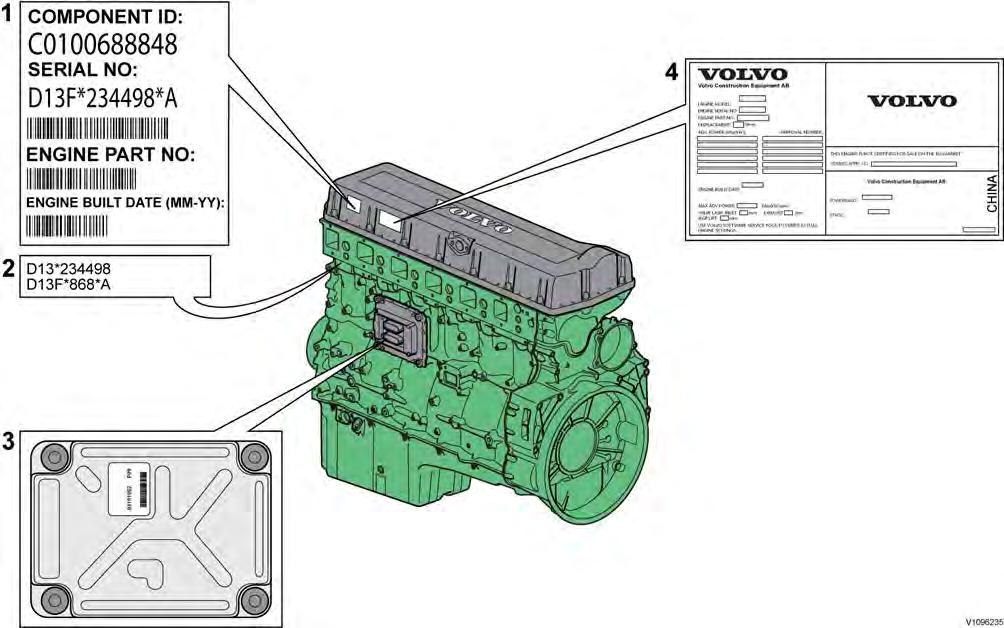
Figure 1
Identification plates, D13F
Identification plate 1
A label located on the valve cover showing the engine's component ID-number, serial number, manufacturing site, engine part number, and engine build date, as well as their bar codes. Manufacturing sites:
A = Skövde, Sweden
E = Curitiba, Brazil
F = Flen, Sweden
L = Lyon, France
Identification plate 2
The engine's serial number, part number, and manufacturing site are stamped into the engine's cylinder block.
Identification plate 3
The hardware component number of the Engine Control Unit (ECU) is located on a label on the back of the ECU.
Identification plate 4
The certification label is located on the valve cover as well as the machine's frame.
Automatic Engine Shutdown
This is a function used to automatically shut down the engine after idling for a certain time. The operator is informed and has the opportunity to cancel the function within one minute, either by increasing the engine speed, shifting gear, or by activating the hand throttle.
Engine protection
The ECU contains functionality designed to protect the engine from damage during extreme operating conditions or from further damage when an essential engine component fails. There are several proactive functions, and different applications have different functions activated. The ones that can be activated are:
High coolant temperature
High intake manifold air pressure
High intake manifold air temperature
High oil temperature
Low oil pressure
Low coolant level
High crankcase pressure
High ECU temperature
Various protective actions such as warning lights, engine torque reduction, engine speed limitation, and vehicle speed limitation may be taken when the above functions reach dangerous levels that may damage the engine. In order to always allow the operator to move a machine away from an unsafe situation, there is a delay of at least 30 seconds before the protective actions (such as forced idle and forced shutdown) are activated after a Key-ON. If the engine has been forced to shutdown or forced to idle due to an active engine protection function, the operator can obtain a 30 second delay by powering down the EMS with a Key-OFF for 7 seconds and then a Key-ON (the EMS is powered down by the Vehicle-ECU (V-ECU) after the ignition key has been in its OFF position for approx. 7 seconds). In addition to the above protective functions, other software functions could request engine protection, such as:
High Altitude (ensures that high compressor discharge temperature is never reached)
Turbo OverSpeed
Low Coolant Temp
Crank Sensor Failure
Gear Ratio
Warning lights
There are two levels for warning lights, an amber caution light and a red stop light.
The amber light indicates a warning situation
The red light indicates that the vehicle must be stopped.
Engine torque limitation
The engine torque can be limited by the engine protection function. Engine torque limitation is active until the parameter
has reached a safe level or until the EMS is powered down.
Forced Idle
The engine can be forced to idle speed by the engine protection function. Forced idle is active until conditions triggering the problem are back within normal working range or the EMS is powered down.
Engine Shutdown
The engine can be forced to shut down after conditions have reached levels that may cause engine failure and the machine speed is below a specified value.
Machine Speed and Engine Speed Limits
The engine protection function can limit the speed of the vehicle and/or the engine's rpm.
Levels of engine protection
Available proactive functions depend not only on the application but also on what level of protection has been activated for the specific machine. Two levels of engine protection are offered, the standard level is Basic protection and the optional level Extended protection. The general difference between basic and extended engine protection is that no active actions such as forced idle and forced shutdown will be taken in basic engine protection (with the exception of crankcase pressure that can cause shutdown in either setup). Warnings will be given to the operator regardless of engine protection level.
Parameters
(ATJ) Injector cylinder 1, calibration (ATK) Injector cylinder 2, calibration (ATL) Injector cylinder 3, calibration (ATM) Injector cylinder 4, calibration (ATN) Injector cylinder 5, calibration (ATO) Injector cylinder 6, calibration (FAU) Automatic engine shut off (FAV) Automatic engine shut off, time (YA) Idle speed, setting
Supplementary information
200 Component locations
Function check 17030-3 Parameter, programming
Diagnostics
Detailed information about the following relevant warnings and error codes is available under the diagnostics tab.
Component Control
EF2117 (ART)
PPID55 (WLO, EXC) MID128
SE2202
FX1006 (WLO) MID128
SE2507
FX1007 (WLO) MID128
SE2203
SE2509
SE2603
SE2606

Document Title: Function Group: Information Type: Date:
Engine, description 200
Profile:
ART, A25F (37214) [GB]
Go back to Index Page
Engine, description
Service Information 2014/8/5 0
Engines D11H, D13H, and D16H are straight six-cylinder, four-stroke, direct-injected diesel engines. They are equipped with a single variable geometry turbocharger (VGT) and feature cooled external exhaust gas recirculation (EGR). They have charge-air cooling with mechanically actuated electronically controlled unit injectors, controlled by the EMS-system. The engines have a one-piece cylinder head with four valves per cylinder and a single overhead camshaft. Rear-mounted timing gear results in a shorter engine and lighter drivetrain installation. The engine brake for articulated haulers, VEB7, does not have the additional Exhaust Pressure Governor, EPG. Sufficient exhaust back-pressure will be controlled via the VGT.
For more information, see:
220 Lubrication system, description
230 Fuel system, description
250 Inlet and exhaust system, description
254 Exhaust Aftertreatment System, description
255 Turbocharger, description
260 Cooling system, description
293 Exhaust Gas Recirculation (EGR), description
For Articulated Haulers:
253 Auxiliary brake (engine braking), description
The cylinders are numbered in sequence, starting farthest from the flywheel. Ignition order: 1-5-3-6-2-4. The engine's rotational direction is counter-clockwise, seen from the flywheel.
Engine identification

Figure 1
Identification plates, D13H
Identification plate 1
A label located on the valve cover showing the engine's component ID-number, serial number, manufacturing site, engine part number, and engine build date, as well as their bar codes. Manufacturing sites:
A = Skövde, Sweden
E = Curitiba, Brazil
F = Flen, Sweden
L = Lyon, France
Identification plate 2
The engine's serial number, part number, and manufacturing site are stamped into the engine's cylinder block.
Identification plate 3
The hardware component number of the Engine Control Unit (ECU) is located on a label on the back of the ECU.
Identification plate 4
The certification label is located on the valve cover as well as the machine's frame.
Automatic Engine Shutdown
This is a function used to automatically shut down the engine after idling for a certain time. The operator is informed and has the opportunity to cancel the function within one minute, either by increasing the engine speed, shifting gear, or by activating the hand throttle.
Engine protection
The ECU contains functionality designed to protect the engine from damage during extreme operating conditions or from further damage when an essential engine component fails. There are several proactive functions, and different applications have different functions activated. The ones that can be activated are:
High coolant temperature
High intake manifold air pressure
High intake manifold air temperature
High oil temperature
Low oil pressure
Low coolant level
High temperature of cooled EGR exhausts after the EGR-cooler
High crankcase pressure
Variable Geometry Turbo valve and position error
High temperature of Smart Remote Actuator
High compressor charge-air temperature (calculated)
High soot load
High differential pressure across Diesel Particulate Filter (DPF)
High exhaust temperature
High ECU temperature
High DPF temperature
Various protective actions such as warning lights, engine torque reduction, engine speed limitation, and vehicle speed limitation may be taken when the above functions reach dangerous levels that may damage the engine. In order to always allow the operator to move a machine away from an unsafe situation, there is a delay of at least 30 seconds before the protective actions (such as forced idle and forced shutdown) are activated after a Key-ON. If the engine has been forced to shutdown or forced to idle due to an active engine protection function, the operator can obtain a 30 second delay by powering down the EMS with a Key-OFF for 7 seconds and then a Key-ON (the EMS is powered down by the Vehicle-ECU (V-ECU) after the ignition key has been in its OFF position for approx. 7 seconds). In addition to the above protective functions, other software functions could request engine protection, such as:
High Altitude (ensures that high compressor charge-air temperature is never reached)
Turbo OverSpeed
Low Coolant Temp
Crank Sensor Failure
Gear Ratio
Regeneration
Warning lights
There are two levels for warning lights, an amber caution light and a red stop light.
The amber light indicates a warning situation
The red light indicates that the vehicle must be stopped.
Engine torque limitation
The engine torque can be limited by the engine protection function. Engine torque limitation is active until the parameter has reached a safe level or until the EMS is powered down.
Forced Idle
The engine can be forced to idle speed by the engine protection function. Forced idle is active until conditions triggering the problem are back within normal working range or the EMS is powered down.
Engine Shutdown
The engine can be forced to shut down after conditions have reached levels that may cause engine failure and the machine speed is below a specified value.
Machine Speed and Engine Speed Limits
The engine protection function can limit the speed of the vehicle and/or the engine's rpm.
Levels of engine protection
Available proactive functions depend not only on the application but also on what level of protection has been activated for the specific machine. Two levels of engine protection are offered, the standard level is Basic protection and the optional level Extended protection. The general difference between basic and extended engine protection is that no active actions such as forced idle and forced shutdown will be taken in basic engine protection (with the exception of crankcase pressure that can cause shutdown in either setup). Warnings will be given to the operator regardless of engine protection level.
Parameters
(FAU) Automatic engine shut off (FAV) Automatic engine shut off, time
(JVL) Injector cylinder 1, calibration E3 Glitch Trim (JVM) Injector cylinder 2, calibration E3 Glitch Trim (JVN) Injector cylinder 3, calibration E3 Glitch Trim (JVO) Injector cylinder 4, calibration E3 Glitch Trim (JVP) Injector cylinder 5, calibration E3 Glitch Trim (JVQ) Injector cylinder 6, calibration E3 Glitch Trim (YA) Idle speed, setting
Supplementary information
200 Component locations
Function check
17030-3 Parameter, programming
Diagnostics
Detailed information about the following relevant warnings and error codes is available under the diagnostics tab.
Component
EF2112 (ART)
PID404 (EXC, WLO)
EF2117 (ART)
PPID55 (WLO, EXC)
EF2127 (ART)
Message ID
MID128 PID404
MID128 PPID55
PPID89 (EXC, WLO) MID128 PPID89
EF2515 (ART)
PSID28 (WLO, EXC) MID128 PSID28
EF2525 (ART)
PID173 (EXC)
SE2510 (WLO)
SE2202
FX1006 (WLO)
SE2507
FX1007 (WLO)
MID128
PID173
MID128 PID175
MID128 PID105
MO2501 MID128 SID27
PPID326 (WLO, EXC)
MID128 PPID326
SE2203 MID128 PID100
SE2509 MID128 PID153
SE2516 MID128 PID412
SE2519 MID128 PID81
SE2603 MID128 PID111
SE2606 MID128 PID110

Service Information
Document Title: Function Group: Information Type: Date:
Engine, sensor positions 200 Service Information 2014/8/5 0
Profile:
ART, A25F (37214) [GB]
Engine, sensor positions
Control unit sensors
This is a brief description of the sensors that are found on the engine.
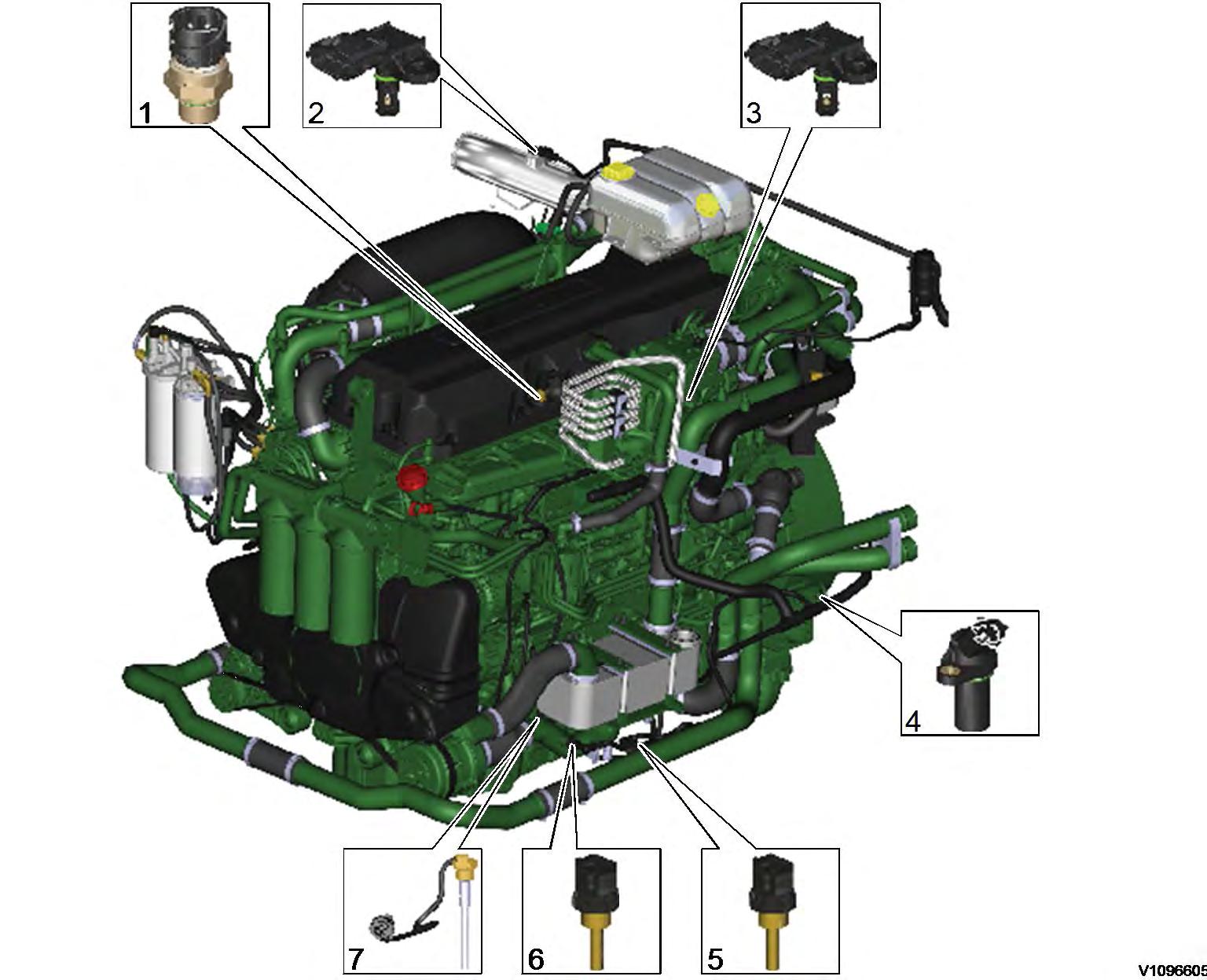
Sensor for crankcase pressure, SE2509
Sensor for charge-air temperature, SE2512 (only engine with EGR)
Sensor for boost pressure/charge-air temperature, SE2507/SE2508 FX1007
Tachometer sensor, flywheel, SE2701
Sensor for coolant temperature, cooling circuit engine/retarder, SE2602
Sensor for coolant temperature, cooling circuit converter, SE2601
Sensor for oil level/oil temperature, SE2205/SE2202 FX1006
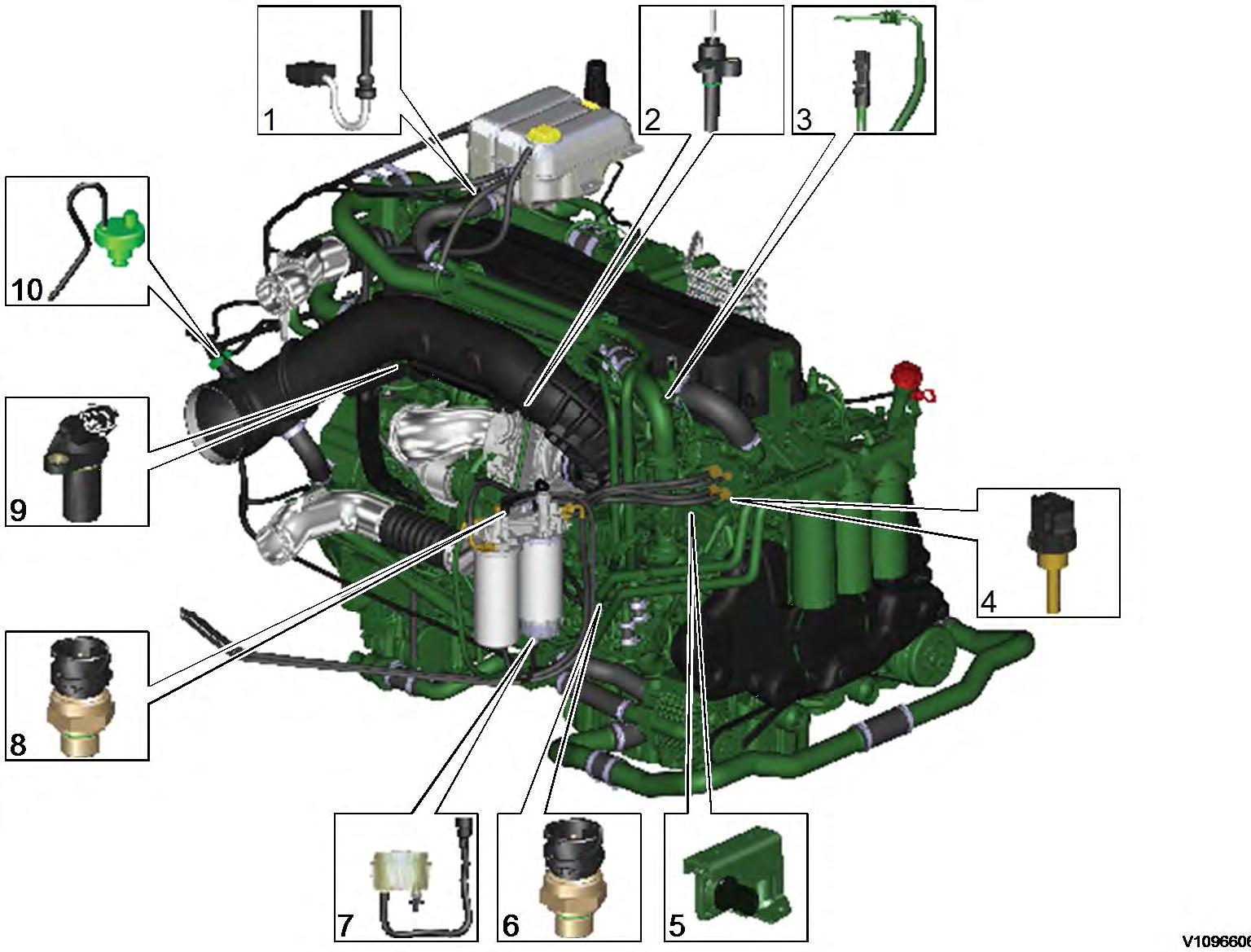
Sensor for coolant level, SE2603
Speed sensor (rpm), turbocharger SE2514
Temperature sensor EGR SE2516
Sensor, coolant temperature SE2606
Sensor, EGR-flow SE2515
Sensor for oil pressure, SE2203
Sensor for water indicator, SE2302
Sensor for fuel pressure, SE2301
Camshaft sensor, engine position, SE2703
Sensor for air pressure/air temperature, SE2501/SE2502 FX1008

Document Title: Function Group: Information Type: Date:
Engine, identification 200 Service Information 2014/8/5 0
Profile:
ART, A25F (37214) [GB]
Engine, identification
Identification plate 1
A decal with the software's ID-number, the engine's serial number and assembly plant is located on the valve cover to ensure installation of correct ECU on the engine in production. On the back of the ECU, there is a decal indicating its hardware number.
Identification plate 2
Engine designation, serial number, part number and assembly plant are stamped in one field on the engine block's left front edge.
Assembly plants:
A = Skövde, Sweden
E = Curitiba, Brazil
F = Flen, Sweden
L = Lyon, France
Identification plate 3
The engine control unit (ECU) has its component number on a plate on the back.
Identification plate 4
The certification decal is located on the valve cover as well as on the left side of the machine's front frame.

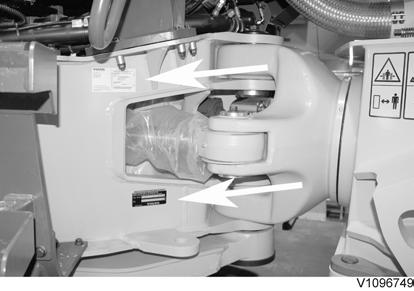
Engine versions
In order to offer machines with lower environmental impact, two main engine types have been developed for machines in the F-series. One version developed for generally available fuel and oil grades, and a version that meets higher emission requirements. The easiest way to see on the machine what version it is, check if it has a diesel particle filter (Diesel Particulate Filter) in the muffler. See:254 Exhaust Aftertreatment System, description Machine
A25F D11F
A25F D11H
A30F D11F
A30F D11H
A35F D13F
A35F D13H
A40F D16F
A40F D16H

Document Title: Function Group: Information Type: Date: VCADS Pro, Operations 200 Service Information 2014/8/5 0
Profile:
ART, A25F (37214) [GB]
VCADS Pro, Operations
The following VCADS Pro operations are available for function group 2. Operations used when changing or working on components are mandatory.
NOTE!
Operations used when changing or repairing components are mandatory.
NOTE!
New operations are developed regularly. For a current list of all tests, see VCADS Pro software.
Tests
Operation
20046-3 Read out engine information
21006-3 Cylinder compression, test
23016-3 Cylinder balancing, test
23017-3 Feed pressure, inspection
23712-3 Injectors shut off, manual
25410-3 Air pump exhaust aftertreatment, test
25411-3 Burner exhaust aftertreatment, test
25412-3 Components ASU, test
25433-3 Fuel system exhaust aftertreatment, bleeding
25434-3 Atomization unit, fuel pressure, adjust
25456-3 Exhaust aftertreatment diagnostics
25457-3 Diesel Particulate Filter Service Regeneration
Application
The test is used to read out engine emissions and engine certification information.
The test shows whether the compression of any cylinder differs from that of the other cylinders.
The test shows whether fuel injection on any cylinder differs from that on the other cylinders.
The test is used to check feed pressure.
The test supplements cylinder balancing. In the test, one injector at a time can be turned off manually.
The test is used to check cut-in and cut-out of the air pump for the exhaust aftertreatment system.
The test is used to diagnose the exhaust aftertreatment system. The test activates the built-in diagnostic function in the control unit. The test indicates any failure with a red light. Read out error codes with operation 17012-3, Error codes.
This subtest is used to check function of the atomization unit's air valve, main air valve, the fuel's shut-off valve, and the fuel pump.
The test is used to purge any air in the fuel system for the atomization unit.
The test is used to adjust the fuel pressure in the atomization unit.
The test is used to check status of the included components for the exhaust aftertreatment.
This operation is used when the soot load is above 1.7, see 254 Exhaust Aftertreatment System, description
In this operation, status and a number of sensor values can be read out during on-going regeneration.
Also check that "DPF differential pressure" is within permitted values, both before and after regeneration, see . 254 Exhaust aftertreatment system, specifications
25537-3 Variable geometry turbo function test
26351-3 Hydraulic cooling fan, test
27102-3 Accelerator pedal, test
The test is used to check function of the variable geometry turbo (VGT).
The test controls the cooling fans' speed control (independent of ordinary control) and is used when adjusting speed.
The test is used to check function of the throttle pedal.
28407-3 Sensor values, monitoring
28420-3 Flywheel and camshaft signal, test
29332-3 Exhaust gas circulation, function test
Calibrations
The tests show values (temperature, rpm, etc.) that the system receives from connected sensors and monitors.
The test is used to use an oscilloscope to check signals from the flywheel and camshaft position sensors.
The test is used to check function of the exhaust gas recirculation.
Operation Application
25536-3 Variable geometry turbo, calibration
Programming
When changing actuator, see 255 Actuator, variable turbocharger, replacing
Operation Application
25801-3 MID 233 Control unit, programming
25802-3 MID 233 Control unit, campaign
28422-3 MID 128 ECU, campaign
28423-3 MID 128 ECU, programming
When changing control unit or when reprogramming complete or part of the software.
Use for campaign programming of the control unit.
Use for campaign programming of the control unit.
When changing control unit or when reprogramming complete or part of the software.

Document Title: Function Group: Information Type: Date:
E-ECU, MID 128, changing pre-programmed ECU 200 Service Information 2014/8/5 0
Profile:
ART, A25F (37214) [GB]
E-ECU, MID 128, changing pre-programmed ECU
Op nbr 200-070
This operation also includes required tools and times for applicable parts of the following operations:
191 Service positions 200 E-ECU, MID 128, changing non-programmed ECU
1. Place the machine in service position, see . 191 Service positions
2. Connect VCADS Pro computer and perform 17030-3 Parameter, programming.
Use the function: Save all read parameters to job card.
3. Run from and including step 3 and on. 200 E-ECU, MID 128, changing non-programmed ECU
4. Connect VCADS Pro computer and perform 17030-3 Parameter, programming.
Program earlier read-out parameters according to the job card.
5. Restore the machine to operating condition.

Document Title: Function Group: Information Type: Date:
E-ECU, MID 128, changing non-programmed ECU 200
Profile:
ART, A25F (37214) [GB]
Service Information 2014/8/5 0
E-ECU, MID 128, changing non-programmed ECU
Op nbr 200-068
This operation also includes the tools and times needed for required parts of the following actions:
191 Service positions
1. Place the machine in service position, see 191 Service positions
2. Connect VCADS Pro computer and perform 28423-3 MID 128 ECU, programming.
When instructed to connect the new control unit, perform steps 3-21.

CAUTION
Always follow instructions according to Electrical system, work instructions, electronic components
3001 Electrical system, special instructions for servicing, electronic components

CAUTION
Always follow instructions according to Electrical system, work instructions, electronic components
3. Removing Open the engine hood.
4. Turn off the main electric power with the battery disconnector.
5. Disconnect the radiator from its front bracket. Swing out the radiator for easier access to the control unit. NOTE!
Protect the charge-air cooler with a cloth or board.
6. Remove the screws, which releases the clamps from the E-ECU.
7. Unplug the connectors EA (7), EB (8), and EI (4).

Oil separator
Pressure-oil line
E-ECU
Connector EI
Cooling unit
Fuel hoses
Connector EA
Connector EB
8. Loosen the pressure-oil line (2) from the oil separator (1).
9. Cut the cable ties on the fuel hoses (6).
NOTE!
Note grouping (bunching) of the hoses to facilitate installation.
10. Loosen the cooling unit (5) from the E-ECU (6 bolts). Carefully move aside the cooling unit.
NOTE!
Work carefully so that hoses for the cooler are not damaged.
11. Remove the E-ECU.
12. Installing Fit the E-ECU.
13. Connect the cooling unit (5) to the E-ECU.

Oil separator
Pressure-oil line
E-ECU
Connector EI
Cooling unit
Fuel hoses
Connector EA
Connector EB
14. Connect the pressure-oil line (2) to the oil separator (1).
15. Connect the connectors EA (7), EB (8), and EI (4).
16. Install the screws that fasten the clamps to the E-ECU.
17. Fasten the fuel hoses (6) according to earlier notes.
18. Connect the radiator to the front bracket.
19. Close the engine hood. NOTE!
When changing pre-programmed control unit, go back to 200 E-ECU, MID 128, changing pre-programmed ECU step 4.
20. Finish VCADS Pro operation 28423-3 MID 128 ECU, programming.
21. Restore the machine to operating condition.

Document Title: Function Group: Information Type: Date: Cylinder compression, PC test 210 Service Information 2014/8/5 0
Profile:
ART, A25F (37214) [GB]
Cylinder compression, PC test
Connect the VCADS Pro computer and carry out 21006-3 Cylinder compression, test. (21006-3) This test indicates if there is any deviation in compression in any cylinder in relation to the other cylinders.

Document Title: Function Group: Information Type: Date: Engine and transmission, removing 210 Service Information 2014/8/5 0
Profile:
ART, A25F (37214) [GB]
Engine and transmission, removing
Op nbr 210-073
This operation also includes required tools and times for applicable parts of the following operations:
191 Service positions 173 Coolant, changing 900 Vacuum pump, connection 715 Protective plate, removing

WARNING
Changing control units between machines, when troubleshooting or repairing, may not take place for any reason without reprogramming.
Incorrect individual settings in the control unit may result in personal injury or machine damage.
For reprogramming and read-out of software, see "VCADS Pro User manual".
1. Place the machine in service position, see 191 Service positions
2. Swing down the front grill and open the engine hood.
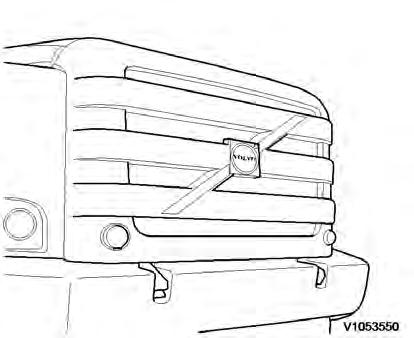
3. Turn off the electric power with the battery disconnect switch.
4. Remove the front and rear underbody skid plates. See 715 Protective plate, removing

Front underbody skid plate
Rear underbody skid plate, left
Rear underbody skid plate, right
Front cross member
Rear cross member
5. Remove the front and rear cross members.
Weight: approx.15 kg (33 lbs)

WARNING
Risk of burns. The fluid may be hot.
6. NOTE!
Take care of waste oil/fluids in an environmentally sound manner.
NOTE!
The oil drain hose is inserted in the pipe for the ladder on the inside of the front grill.
Drain the gearbox oil.
Volume, see: 400 Drive train capacities

7. Drain the coolant, see: 173 Coolant, changing
Work in engine compartment
8. Remove the front protective plates and the belt guard.
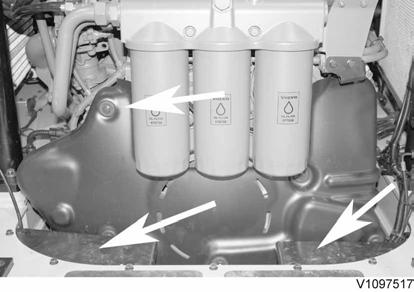
9. Remove the bolt and swing out the radiator.

NOTE!
Keep in mind that the cooling fins are easily damaged. To protect them, install a sheet of plywood or similar.
10. Loosen the belt tensioners with a half inch ratchet handle and remove the three belts.
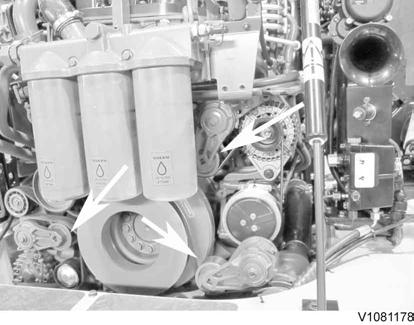
11. Loosen and remove the connections for the preheating coil and the pipe for compressed air from the compressor. Remove the coolant hoses and the joint. Remove the compressor's signal line.

1. 2. 3. 4. 5. Compressed air pipe Plus cable Joint
Lower coolant hose
Upper coolant hose
12. Unplug the connector (EL). Remove the cable clamp.


13. WARNING
Do not disconnect or loosen connections for the air conditioning unit (AC). Risk of gas leakage.
Unplug the connector for control current to the AC compressor. Remove the bolts and remove the AC compressor. Put it aside.

14. Remove the alternator's ground cable.
15. Loosen the connections for the temperature sensors. Remove the upper and lower cooling hoses from the secondary coolant pump.
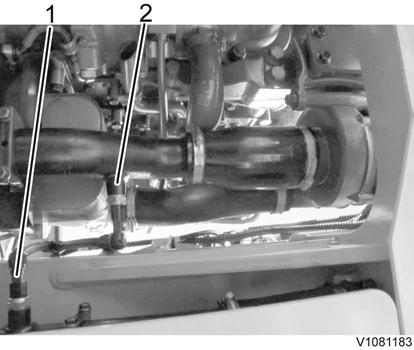
View from below
1. 2.
Temperature sensor primary circuit , SE 2602
Temperature sensor secondary circuit, SE 2601
16. Remove the secondary pump.
17. Loosen the hoses for the expansion tank. Unplug the level sensor's connector SE 2603 down on the expansion tank. Loosen the four bolts for the foot step and lift it away.

